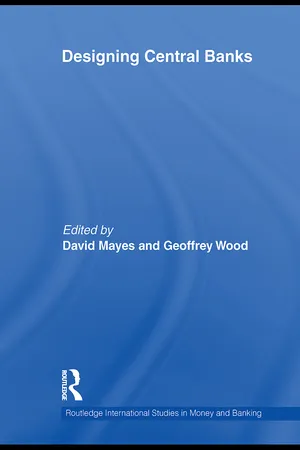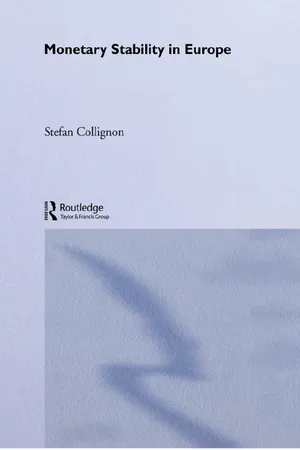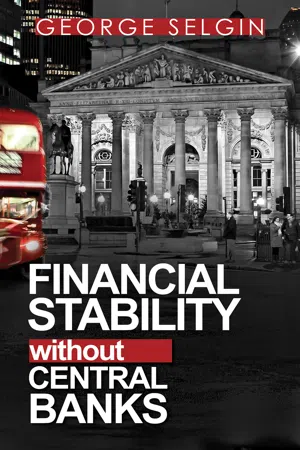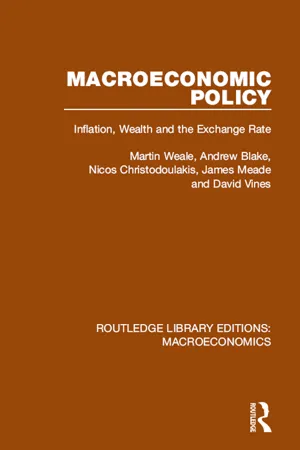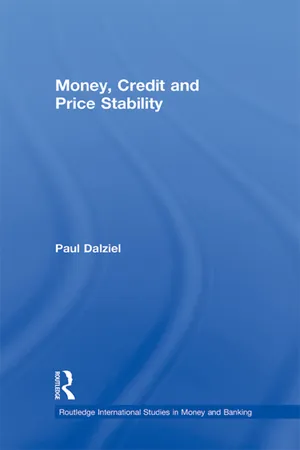Economics
Price Stability
Price stability refers to a situation where the general price level in an economy remains relatively constant over time, with low and predictable inflation or deflation. It is a key goal of monetary policy and is important for promoting economic growth and stability. Price stability helps businesses and consumers make informed decisions and reduces uncertainty in the economy.
Written by Perlego with AI-assistance
Related key terms
Related key terms
1 of 4
Related key terms
1 of 3
9 Key excerpts on "Price Stability"
- eBook - ePub
- Heinz Herrmann, David Mayes, Geoffrey E Wood(Authors)
- 2009(Publication Date)
- Routledge(Publisher)
4 How should central banks define Price Stability? 1 Mark A.WynneIt is now widely accepted that Price Stability should be a (if not the) primary objective of central banks. Even for central banks with dual mandates, such as the Federal Reserve, the achievement of Price Stability is often seen as a key prerequisite to the attainment of other mandated objectives such as maximum employment. In this chapter I look at how central banks should define Price Stability, starting with current practices. I consider three questions. First, should Price Stability be defined in terms of a relatively broad price index, such as the deflator for Gross Domestic Product, or in terms of a narrower measure, such as a Consumer Price Index (CPI)? Second, should Price Stability be defined in terms of a headline measure of inflation, or in terms of a core measure that routinely excludes or down-weights the prices of certain goods and services? And third, should Price Stability be defined as no change in the chosen price index, or as a positive rate of increase in the chosen price index? The choice of the horizon over which Price Stability is to be maintained is arguably as important as the manner in which Price Stability is defined, but I will not address that question here. I will touch briefly on the question of how asset prices should figure in the definition of Price Stability, but I will not visit the well-trodden ground of how monetary policy should respond to asset price developments.The Federal Reserve is perhaps unique among the major central banks in that it does not have an explicit numerical price objective. Former Federal Reserve Chairman Alan Greenspan famously defined Price Stability in qualitative terms as a situation in which ‘households and businesses need not factor expectations of changes in the average level of prices into their decisions’ (Greenspan, 1994a).2 However, as Table 4.1 shows, many central banks, even those that would eschew the label of ‘inflation targeter’ do have explicit numerical price objectives. In all cases, these price objectives are specified in terms of a measure of consumer price inflation. Furthermore, almost all are defined in terms of the headline rather than a core measure, although that was not always the case. The Reserve Bank of New Zealand (RBNZ), which pioneered inflation targeting, switched from defining its target in terms of core to headline CPI in 1997.3 - eBook - ePub
- Stefan Collignon(Author)
- 2003(Publication Date)
- Routledge(Publisher)
7Sustaining price Price Stability
In the last two chapters we have emphasised the importance of authorities’ relative preference for output and Price Stability reflected in the policy coefficient A. Knowing the relative importance given to these policy objectives is crucial to the assessment of net benefits which derive from belonging to the monetary union to its members. In this chapter we will look at the commitment to Price Stability by European authorities from different angles in order to get a clearer view of the relative weight given to these policy objectives. We will first look at the concept of Price Stability then at possible inflationary biases in monetary policy objectives and finally, at the European policy frame.Defining Price Stability as a policy objective
Maintaining Price Stability is the primary objective of European Monetary Union (EMU) (Treaty of European Union (TEU) arts. 2, 3a, 105 and Protocol on the Statute of the European System of Central Banks (ESCB) and European Central Bank (ECB)). No doubt this reflects the political consensus that has emerged in Europe around the German model. In the academic field, convictions about the benefits are less unanimous. It is often said we lack an account of the cost of inflation that matches the intensity with which inflation is denounced by policy makers and disliked by the general public (Fischer 1994).In the 1950–70s orthodox economic theory was built on the Phillips curve tradeoff between inflation and output. But after the Great Inflation, these models lost their attraction. As Lucas (1976) put it:The inference that permanent inflation will therefore induce a permanent economic high is no doubt (…) an cient, yet it is only recently that this notion has undergone the mysterious transformation from obvious fallacy to the comerstone of the theory of economic policy.Friedman replaced the simple Phillips curve with the Natural Rate Hypothesis (1968). This eliminated the inflation/output trade-off in the long run but still kept it in the short term. Ultimately, even this was put into question by neoclassical economists who claimed that systematic monetary policy will affect only nominal magnitudes and not real variables like output and employment, even in the short run (Lucas 1972; Sargent 1973; Barro 1976). If the real world is effectively independent from nominal variables, it is not obvious why inflation would represent a cost. Theory has moved from positive to zero benefit from inflation. In the first chapter we have argued that stable money matters in the long run because it sustains the fundamental norms of a market economy. In this chapter we will focus on the short-run policy preferences for output versus inflation stabilisation. - eBook - ePub
Paper Money Collapse
The Folly of Elastic Money
- Detlev S. Schlichter(Author)
- 2014(Publication Date)
- Wiley(Publisher)
Part Three Fallacies about the Price Level and Price-Level StabilizationPassage contains an image
Chapter 5 Common Misconceptions Regarding the Price Level
The main reason why the phenomena analyzed in the previous chapters, although powerful and for a long time the intense focus of theoretical investigation, are not at the forefront of present monetary policy discussions is that it is widely believed today that money that is broadly price-level stable, meaning, whose purchasing power as measured by some price index does not decline too rapidly or is not otherwise too volatile, is also “neutral” money, that is, this money should have no distorting or disruptive influences on the real economy. It would not be an exaggeration to say that a reasonably stable price level has become the accepted definition of good money, and that, as long as the central bank delivers an acceptable degree of price-level stability, it must have done a good job. Price level here means any of the broad-based statistical averages of prices in the economy that are considered reasonable representations of money’s purchasing power, such as, most important, the consumer price index, and sometimes the producer price index and potentially others. In today’s debate, a reasonably stable price index has become shorthand for monetary stability. This is not a new idea but has been deeply engrained in neoclassical economics. In his 1931 book Prices and Production, which provides an excellent exposition of the Austrian Business Cycle Theory, Hayek quotes Cambridge economist Arthur C. Pigou as saying that “if countries with paper currencies will regulate them with a view to keeping the general price level in some sense stable, there will be no impulses from the side of money which can properly be called ‘autonomous.’ ”1 - eBook - ePub
- George Selgin, Kevin Dowd, Mathieu Bédard(Authors)
- 2018(Publication Date)
- London Publishing Partnership(Publisher)
Throw in the subprime crisis, and the Fed’s record becomes still worse. In short, anyone who claims that the Fed’s establishment resulted in a definite if delayed reduction in US financial instability is guilty of ignoring what the record actually shows.Price StabilityWhat about Price Stability? Would a free banking system automatically achieve it? Not quite. Nor should we want it to! I struggled with the title assigned to my talk because in my view a stable price level or inflation rate is neither desirable nor necessary for overall monetary and macroeconomic stability.The simple reason for that is that the general level of prices can rise or fall for more than one reason and it is very important to distinguish these different reasons.When central bankers talk about deflation today, they have a tendency to assume that the only way deflation can happen is because spending is collapsing. And of course, if spending is collapsing then that is unfortunate. The decline in prices that happens is itself actually not what is bad. What is bad is the fact that people are spending less and this is not only reflected in falling prices but, more seriously, reflected in declines in output. With less output, you also have less employment.This is what typically happens in downturns, such as the downturns of 2008–9 or 1936–38 or 1930–33. By the way, in every one of these episodes I have just mentioned, Federal Reserve misconduct played a crucial role.But in any event, in these episodes of deflation, which are usually relatively short term, demand collapses and therefore there is less spending to purchase goods. As fewer goods are being demanded, less labour will be demanded as well, so unemployment ensues.But, prices can also fall because there is more output of goods as a result of supply improving, rather than demand suffering a setback. That is quite a different sort of deflation. Here we have more goods being produced at cheaper costs, prices fall to reflect falling costs, but quantities are growing. That is, the quantity demanded and supplied is going up.Most deflation throughout history, until the twentieth century, was this good sort of deflation. For example, in both the UK and the US, between 1873 and 1896 or so, we had a long stretch of deflation at a mild annual rate of something like 2 per cent. - eBook - ePub
Macroeconomic Policy
Inflation, Wealth and the Exchange Rate
- Martin Weale, Andrew Blake, Nicos Christodoulakis, James Meade, David Vines(Authors)
- 2015(Publication Date)
- Routledge(Publisher)
Chapter Three The dynamics of price stabilizationDOI: 10.4324/9781315674520-43.1 Introduction
So far we have studied the problem of economic policy in a static context. Taking a particular structure of the economy we have investigated the necessary adjustments to monetary and to fiscal policy which are needed to achieve particular short-term variations in prices and in national wealth. In this chapter we extend the previous analysis to a dynamic context so as to focus on two particular dynamic problems: (i) the wage – price spiral and (ii) the role of a target exchange rate. We neglect other important dynamic issues and, in particular, the dynamics of wealth accumulation, which we leave to Chapter 4 .We set out a model, which is intrinsically dynamic. Throughout this chapter, as in the previous one, we work with a price target rather than a Money GDP target. The motive for doing this is once again to maintain algebraic simplicity.We first explore the steady-state properties of the model, showing the adjustments to policy instruments which are needed to achieve particular long-run variations in target values or supply-side conditions. These steady-state changes are a consequence solely of the character of the model, and cannot reflect any preference to use policy rules in any particular way.We then consider various ways in which one could specify an active policy designed to achieve Price Stability, indicating that either monetary policy (which we demonstrate can be expressed using the interest rate as an instrument, and working through the medium of a target exchange rate) or fiscal policy should be emphasized for this purpose. We test for the asymptotic stability of the economy using either monetary or fiscal stabilization rules and show that, if the fiscal instrument is a tax rate, and if wages are strongly indexed to prices, a fiscal rule is likely to be unstable. This result meets the Lucas critique, since it is found when expectations are model-consistent. It is robust to the way in which expectations are formed, since it also holds when expectations are assumed to be adaptive. - Sven Larson(Author)
- 2019(Publication Date)
- Routledge(Publisher)
The second criterion of our stability definition is temporal. We have already stated that agents perceive differences between stability and instability in terms of money prices. Obviously, what is of concern to economic agents is the horizon over which money prices remain unchanged: the longer they stay unchanged, the better. Therefore, when we define macroeconomic stability — and when we seek to define it in terms that make sense to economic agents — we need a definition where there is room for less favorable states of affairs than macroeconomic stability. Therefore, let us suggest that when prices have remained unchanged for at least three periods of economic activity (three market days) the macroeconomy is in a state of stability.The choice of three periods instead of two or one should be obvious; it is much less clear why we do not choose four, five or twenty. A three-period convention makes sense from both sides of the pricing process. Firms regard three periods as a reasonable planning horizon if managements produce quarterly reports to shareholders (given that the market period is one month); since firms are price setters, it presents itself immediately that they also exercise product pricing over three months at a time. We should remember, though, that as we defined conventional preferences around confidence in sections 1.2 –1.3 the perception of what is an “acceptable” state of stability will change if the economy remains stable for a long time; there is no natural or objectively “true” time horizon of macroeconomic stability. The confidence spectrum will, so to speak, climb and place stability at a higher level, meaning that agents demand more than three periods of unchanged prices to be satisfied. For our present analysis, though, we shall stop at three periods.Since consumers are confident in a state of stability (though not euphoric) there is a small but stable fraction of income devoted to precautionary saving. This money is set aside in the highest form of liquidity to be easily accessible should agents learn that they have been overly optimistic and too confident. They have a preference for liquidity that is governed by their preference for sticky prices, as described in section 1.3- eBook - ePub
- Jakob De Haan(Author)
- 2012(Publication Date)
- Routledge(Publisher)
4 From low inflation to Price Stability in Germany
Measurement, costs and benefits Karl-Heinz Tödter and Gerhard Ziebarth* If there is anything in the world which ought to be stable it is money, the measure of everything which enters the channels of trade. (Francois Le Blanc 1690, quoted from Einaudi, 1953: 233)4.1 Introduction
Over time, even moderate inflation erodes the value of money in its role as a unit of account, a medium of exchange and a store of value. This is why people dislike inflation (Shiller 1997). In this chapter, we investigate a central economic policy problem for Germany that has recently been posed by Feldstein (1996) as follows: ‘If the true and fully anticipated rate of inflation … has stabilised at two percent, is the gain from reducing inflation to zero worth the sacrifice in output and employment that would be required to achieve it?’The Deutsche Bundesbank was confronted with a similar situation in the years after German unification, when inflation ranged between 3 and 4 per cent. This complex matter necessitates addressing three issues: What is the true rate of inflation? What are the costs of disinflation? What are the benefits of Price Stability?The notion that Price Stability should be the priority target of monetary policy has become widely accepted. High and volatile inflation distorts economic allocation and curbs economic growth and welfare. But, nonetheless, opinions differ substantially with regard to the assessment of moderate inflation, especially if the benefits of Price Stability have to be weighed against the costs of disinflation.1 Should a moderate pace of inflation be tolerated or even aimed at by economic policy-makers, rather than there being undue zeal to fight inflation?Our study tries to give an empirically founded answer, from a German perspective, to these questions. Measurement issues in the consumer price index are discussed in Section 4.2 . Section 4.3 presents empirical evidence on the sacrifice ratio of disinflation policies. Section 4.4 turns to the benefits of Price Stability: we estimate the effects of inflation on consumption allocation, housing demand, money demand and government debt service. For a permanent reduction of inflation by 2 percentage points (from 2 per cent to zero), we find that the benefits of Price Stability exceed the costs of disinflation by more than 1 per cent of the GDP. Section 4.5 - eBook - ePub
- Paul Dalziel(Author)
- 2000(Publication Date)
- Routledge(Publisher)
1 The quest for Price StabilityOne of the oldest ideas in economics is the quantity theory of money; indeed, The New Palgrave describes the proposition that increases in the stock of money eventually cause prices to rise in the same proportion as being ‘older than economic theory itself’ (Bridel, 1989, p. 298). With suitable extensions to recognise the impact of changes in the volume of economic transactions or the velocity of circulation (Fisher, 1911), and more generally the impact of changes in real money demand (Friedman, 1956), this long-standing theory remains the starting point for much modern analysis in monetary economics. In particular, its strong causal link between changes in the money supply and changes in the price level offers a clear strategy for achieving Price Stability: those responsible for controlling the money supply should be given a statutory duty to implement policy that is consistent with a pre-announced low inflation target. New Zealand was the first country to reform its central bank legislation along these lines (in 1989), and its example has been followed by others since (including Canada in 1991, the United Kingdom in 1997 and the European Central Bank in 1998). The result has been a clear improvement in inflation performance by the end of the twentieth century compared with the previous three decades (see Figure 1.1 ).Despite the success of the new monetary framework in controlling inflation, there remains a puzzle that this book seeks to address. To be effective for policy purposes, the quantity theory of money requires that the central bank has the ability to determine the nominal money supply exogenously (that is independently of other economic influences) so that its growth can be set to be consistent with the bank’s inflation target. In practice, however, monetary authorities do not have direct control over the monetary aggregates, and indeed the English-language central banks that attempted to target money supply growth rates in the 1970s abandoned that practice in the 1980s. The difficulty is that virtually all money in modern economies takes the form of bank deposits that are created, not by the monetary authorities, but by the credit extension activities of private sector banks. Consequently central banks are able to influence the volume of this credit-money only indirectly, particularly through policy-induced changes in the banking system’s base interest rate. Analysing the critical roles of credit in determining money supply growth and as a key component of the transmission mechanism from monetary policy to Price Stability is the primary subject of this book and provides its title, Money, Credit and Price Stability - eBook - ePub
- George F. Warren, Frank A. Pearson(Authors)
- 2017(Publication Date)
- Routledge(Publisher)
figure 2 , that is, the changes in value when compared with the average of many commodities rather than with the single commodity, gold. This gives some idea of how prices of these things would have fluctuated had there been a stable measure of value. Prices would have been more stable than this figure indicates because changes due to the value of money decidedly increase the fluctuations that are due to supply of the commodity and demand for it. Whenever prices start to move violently regardless of the cause, they overshoot the mark. Changes in the general level of prices also cause changes in demand. For example, the rise in the value of gold resulted in unemployment, reduced the demand for cotton and pine, and caused some of the decline from 1929 to 1932. A stable general price level would reduce these price fluctuations.Changes in demand, or exhaustion of supplies, will cause some commodities to rise in price with a stable average price level. Other commodities would decline. Seasonal fluctuations would continue. The fluctuating mass would be stable, but no one thing in the mass would be stable. Because of exhaustion of the forests, lumber would rise in price as it has been doing for a century. Because of new processes, iron would become cheaper. Many of the products that result from biological action would rise in price, and many that result from mechanical action would decline.Stable wage level undesirable.—Some persons have thought that an ideal money would be a wage money so that wages would always be stable, and that increases in the efficiency of labor should result in a decline in commodity prices and stable wages rather than a stable average of commodity prices and rising wages. This would be extremely unfortunate for laborers, farmers, and all other business men and a serious menace to society as a whole.There is a steady increase in the work accomplished by an hour of labor. The increase in efficiency in production of basic commodities per capita was about 1.7 per cent per year (page 56). When one hires labor, it is not hours of social contact that he desires. It is output. If one should borrow a wage money which would buy him ten days of labor and agree to repay it at a later date, he would be returning to the creditor a greater product than that which he borrowed. Since it is product and not hours of society that the debtor and creditor are interested in, such a money would be unjust.
Index pages curate the most relevant extracts from our library of academic textbooks. They’ve been created using an in-house natural language model (NLM), each adding context and meaning to key research topics.
Explore more topic indexes
Explore more topic indexes
1 of 6
Explore more topic indexes
1 of 4
